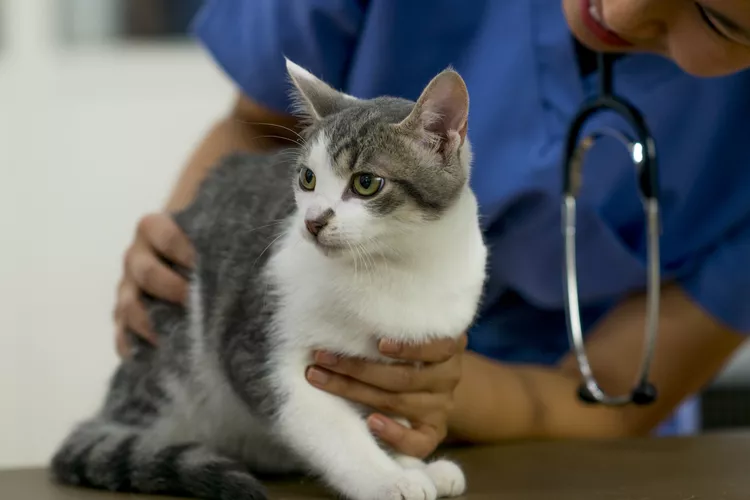- 01 of 04
Bite Wound
Before signs of rabies appear, you may notice a bite wound or abscess on your cat. This might have come from wildlife, another cat, or even a dog, any of which may carry rabies. Additionally, if you know your cat was near wildlife, such as a bat, skunk, or raccoon, even if you don't see an obvious bite wound, you should contact your veterinarian.
Any bite wound or other injury should be treated by a veterinarian as soon as possible. Discuss your cat's rabies vaccination history with your vet so you can understand the risk of them contracting this disease.
If the cat has previously been vaccinated against rabies, your vet may recommend re-vaccination after the bite, especially if the vaccine is overdue. This can boost immunity and prevent rabies from advancing to the nervous system and becoming fatal.
If the cat has never been vaccinated for rabies, then there is no treatment available. These animals typically need to be quarantined and observed for signs of rabies. Sadly, humane euthanasia is the only option once signs of rabies begin for any animal, whether they have been vaccinated or not.
The typical incubation period for rabies in cats is one to three months after exposure, but it may be longer in some cases. During this time, the virus travels through the body to the nervous system, eventually reaching the brain. The signs of rabies infection appear after this incubation period. Once signs of rabies appear, death typically occurs within 10 days.
Note that cats may be able to spread rabies several days before signs appear.
- 02 of 04
Prodromal Stage
This is when the first signs of rabies affect a cat's behavior. You may notice that your outgoing cat is suddenly shy and hiding. Fearful cats might even become more confident. The cat may become lethargic and have a decreased appetite or fever.
Behavior and personality changes vary by case; some cats will exhibit very noticeable personality changes at this stage while other cats will only show mild changes at first, making it difficult to identify the problem.
The prodromal stage of rabies usually lasts two to three days.
- 03 of 04
Excitative (Furious) Stage
During this stage, cats tend to show more extreme behavior changes. They appear agitated and restless and often overreact to normal sights and sounds. Many cats will become aggressive for no apparent reason. They may attack people, other animals, and even objects without provocation. They may also show signs of incoordination, loss of balance, hypersensitivity to touch, or seizures.
This stage can last one to seven days and may somewhat overlap the other stages or may be completely absent in some infections.
- 04 of 04
Paralytic Stage
During the final stage of rabies, the cat develops weakness and eventually paralysis in the head, neck, and chest. The larynx will become paralyzed and the cat will no longer be able to vocalize or swallow. This is when the well-known sign of "foaming at the mouth" begins; if the cat is unable to swallow, salivation becomes excessive.
As weakness turns to paralysis, the muscles that control breathing can no longer function, leading to death.
The paralytic stage of rabies lasts two to four days and ultimately leads to death.
Quarantine
It's important to understand that each case of rabies is unique and the cat's signs may not match the typical signs described above.
Cats with possible exposure to rabies will need to be quarantined to protect people and other animals from exposure. Sick animals with suspected rabies will need to be euthanized.
If any cat has bitten a person, that cat will need to be quarantined for 10 days. This is because we know that a cat that is contagious will have signs of rabies within this time. If the cat does not show any symptoms during the quarantine and remains healthy, then the cat was not contagious at the time of the bite and would not have transmitted rabies to that person.
The only way to definitively diagnose rabies is through analysis of the brain tissue after death. The brain must be sent to a pathologist for testing.
-
What does a cat with rabies look like?
Cats with rabies may have a change in behavior and turn aggressive, irritable, and angry towards other animals and humans. A cat with rabies may also have neurological signs including loss of balance, seizures, or disorientation. They may also drool or foam at the mouth.
-
How long can a cat live with rabies?
Cats with rabies will die within 10 days of symptoms developing, however, the incubation period after a bite can be months.
-
When is a cat contagious with rabies?
Rabies is spread through saliva, and it can take a cat anywhere from a couple of weeks to a couple of months to become contagious after being infected. Usually, they become contagious one to five days before neurological symptoms develop.




















